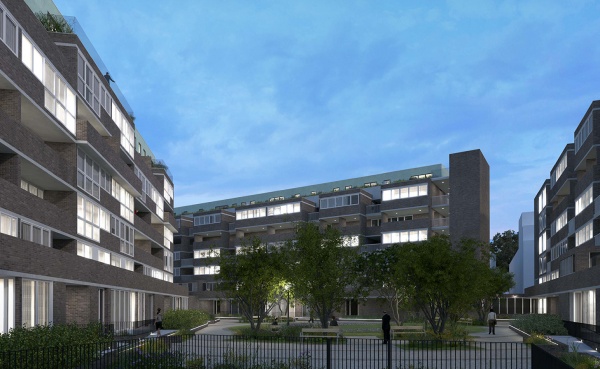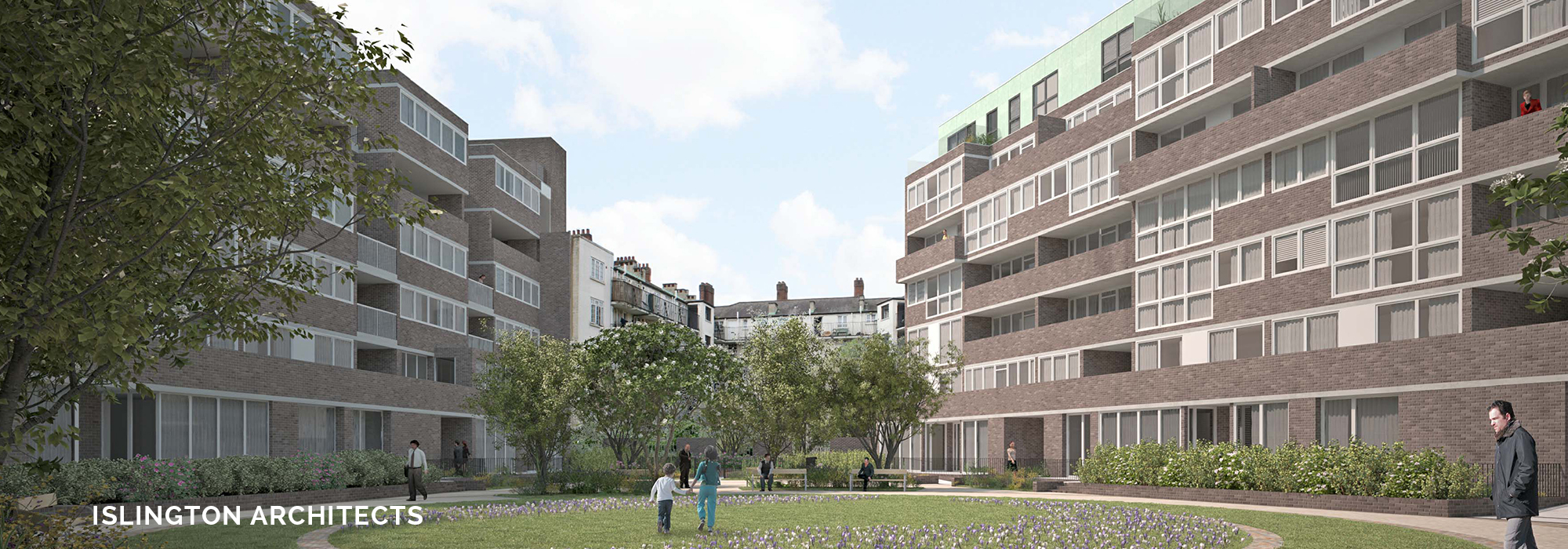Out of a total of 54 homes, this scheme will provide 27 new affordable homes which will be of direct benefit for the local community. It forms part of a wider Islington Housing New Build programme which seeks to provide 550 new affordable homes by 2022.
The very complex infill scheme seeks to address anti-social behaviour which has been a problem due to a large number of public entrances into the estate which will be reduced. The central podium, a hard surfaced area that lies between the three blocks at first floor level which are sited in a triangle formation, not only offers poor quality amenity space to the residents, it is in need of repair. Its removal creates new at level amenity space and redundant pram stores at upper levels are turned into ‘slotted in’ residential units in locations that do not appear obvious at first glance.
An additional floor of flats will be provided on the top of the three existing blocks, and an eight-storey residential block will be provided on the site of an existing shop unit. Commercial floorspace is reinstated at ground and first floor levels. It is Islington policy to support the local economy, and the re-provision of the existing retail store will ensure that a small business remains on the site.
The rooftop development and infill dwellings allow for an increase in housing in a densely developed inner London borough with minimal land take.


In addition to the housing elements, consideration has been given to the landscaping and amenity spaces on the estate. Currently the centre of the site is dominated by a centrally located podium at first floor level, underneath which garages are located. The proposal includes the removal of these structures, and to replace them with a centrally located communal landscaped garden, and ground floor flats which overlook the communal amenity space. LB Islington has the lowest amount of open space for any Local Authority in the country. The current amenity space which is dominated by hard landscaping will be transformed into greened spaces and the provision of allotment gardens which will benefit the existing and new residents. Access to the semi-public space will be restricted to residents, engendering common ownership. It will also benefit from overlooking by the new dwelling units at ground floor level, making it a secure and safe space.
During the design process for the Triangle Estate scheme, the HTA Planning team provided guidance to the design team and other specialist consultants on the interpretation of policy. Key issues included:
- ensuring dwelling units achieve high amenity, particularly in relation to floor to ceiling heights of the infill units which are constrained by the existing built structure and the siting of the MVHR units to ensure good air quality;
- the impact on amenity for existing residents and neighbours of the rooftop development in relation to overlooking and maintaining privacy,
- ensuring that noise transfer between existing residents on the upper floor of the existing block is mitigated;
- the provision of benefits for the existing residents through improved accessibility, reduced anti-social behaviour, and usable communal open space.
- consideration of the proposal in relation to the neighbouring heritage assets (Conservation Areas); and,
- design of the infill 8 storey block and rooftop units to complement the architecture of the estate and surrounding environment.
HTA Planning also provided advice in relation to the community consultation process, specifically: the timing of consultation events; the information presented to residents; the analysis of the consultation results; and the provision of this information to the architects and other consultants to ensure that designs were amended to reflect feedback.
HTA Design’s planning team have negotiated a series of complex challenges associated with a number of development typologies in one location. We have worked closely with the local authority planners, the design team and the client to secure planning consent on one of the first examples of a development that leads the way in demonstrating that via rooftop and infill development, additional homes can be navigated through the planning process to create new homes across London with minimal land-take. This scheme demonstrates what can be done focussing on small sites and also the complexities that arise with rooftop development.


